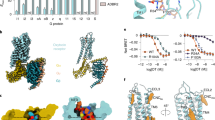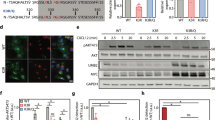Abstract
In this study, we investigated the functional role of the localization of human OTR in caveolin-1 enriched membrane domains. Biochemical fractionation of MDCK cells stably expressing the WT OTR-GFP indicated that only minor quantities of receptor are partitioned in caveolin-1 enriched domains. However, when fused to caveolin-2, the OTR protein proved to be exclusively localized in caveolin-1 enriched fractions, where it bound the agonist with increased affinity and efficiently coupled to Gαq/11. Interestingly, the chimeric protein was unable to undergo agonist-induced internalization and remained confined to the plasma membrane even after prolonged agonist exposure (120 min). A striking difference in receptor stimulation was observed when the OT-induced effect on cell proliferation was analysed: stimulation of the human WT OTR inhibited cell growth, whereas the chimeric protein had a proliferative effect. These data indicate that the localization of human OTR in caveolin-1 enriched microdomains radically alters its regulatory effects on cell growth; the fraction of OTR residing in caveolar structures may therefore play a crucial role in regulating cell proliferation.
This is a preview of subscription content, access via your institution
Access options
Subscribe to this journal
Receive 50 print issues and online access
$259.00 per year
only $5.18 per issue
Buy this article
- Purchase on Springer Link
- Instant access to full article PDF
Prices may be subject to local taxes which are calculated during checkout





Similar content being viewed by others
References
Anderson RG . 1998 Ann. Rev. Biochem. 67: 199–225
Anderson RG, Kamen BA, Rothberg KG, Lacey SW . 1992 Science 255: 410–411
Bonifacino JS, Dell'Angelica EC . 1999 J. Cell Biol. 145: 923–926
Bussolati G, Cassoni P . 2001 Endocrinology 142: 1130–1136
Cassoni P, Sapino A, Fortunati N, Munaron L, Chini B, Bussolati G . 1997 Int. J. Cancer 72: 340–344
Cassoni P, Sapino A, Stella A, Fortunati N, Bussolati G . 1998 Int. J. Cancer 77: 695–700
Ceresa BP, Schmid SL . 2000 Curr. Opin. Cell Biol. 12: 204–210
Chini B, Mouillac B, Ala Y, Balestre M, Trumpp-Kallmeyer S, Hoflack J, Elands J, Hibert M, Manning M, Jard S, Barberis C . 1995 EMBO J. 14: 2176–2182
Chini B, Mouillac B, Balestre M, Trumpp-Kallmeyer S, Hoflack J, Hibert M, Andriolo M, Pupier S, Jard S, Barberis C . 1996 FEBS Letts. 397: 201–206
Cormack BP, Valdivia RH, Falkow S . 1996 Gene 173: 33–38
DeFea KA, Zalevsky J, Thoma MS, Dery O, Mullins RD, Bunnett NW . 2000 J. Cell Biol. 148: 1267–1281
Dessy C, Kelly RA, Balligand JL, Feron O . 2000 EMBO J. 19: 4272–4280
Elands J, Barberis C, Jard S . 1988 Am. J. Physiol. 254: (Suppl E) 31–38
Gimpl G, Fahrenholz F . 2000 Eur. J. Biochem. 267: 2483–2497
Gumbiner B, Stevenson B, Grimaldi A . 1988 J. Cell Biol. 107: 1575–1587
Gutkind JS . 1998 Oncogene 17: 1331–1342
Hailstones D, Sleer LS, Parton RG, Stanley KK . 1998 J. Lipid Res. 39: 369–379
Hansen SH, Sandvig K, van Deurs B . 1993 J. Cell Biol. 121: 61–72
Hoare S, Copland JA, Strakova Z, Ives K, Jeng YJ, Hellmich MR, Soloff MS . 1999 J. Biol. Chem. 274: 28682–28689
Kirk CJ, Guillon G, Balestre M, Jard S . 1986 Biochem. J. 240: 197–204
Klein U, Gimpl G, Fahrenholdz F . 1995 Biochem. 34: 13784–13793
Laemmli UK . 1970 Nature 227: 680–685
Lewis TS, Shapiro PS, Ahn NG . 1998 Adv. Cancer Res. 74: 49–139
Oakley RH, Laporte SA, Holt JA, Barak LS, Caron MG . 2001 J. Biol. Chem. 276: 19452–19460
Ohmichi M, Koike K, Nohara A, Kanda Y, Sakamoto Y, Zhang ZH, Hirota K, Miyake A . 1995 Endocrinol. 136: 2082–2087
Okamoto T, Schlegel A, Scherer PE, Lisanti MP . 1998 J. Biol. Chem. 273: 5419–5422
Ostrom RS, Violin JD, Coleman S, Insel PA . 2000 Mol. Pharmacol. 57: 1075–1079
Pierce KL, Luttrell LM, Lefkowitz RJ . 2001 Oncogene 20: 1532–1539
Rybin VO, Xu X, Lisanti MP, Steinberg SF . 2000 J. Biol. Chem. 275: 41447–41457
Scheiffele P, Verkade P, Fra AM, Virta H, Simons K, Ikonen E . 1998 J. Cell Biol. 140: 795–806
Simons K, Toomre D . 2000 Nature Rev. Mol. Cell. Biol. 1: 31–39
Strakova Z, Copland JA, Lolait SJ, Soloff MS . 1998 Am. J. Physiol. 274: (Suppl E) 634–641
Strakova Z, Soloff MS . 1997 Am. J. Physiol. 272: (Suppl E) 870–876
Thibonnier M, Auzan C, Madhun Z, Wilkins P, Berti-Mattera L, Clauser E . 1994 J. Biol. Chem. 269: 3304–3310
Acknowledgements
We thank Dr V Pliska helpfully commenting on the binding assays and Prof N Borgese for critically reading the manuscript. This work was supported by a grant from the AIRC (Italian Association for Cancer Research) to B Chini and a MURST grant (Cofin 2000) to M Parenti.
Author information
Authors and Affiliations
Corresponding author
Rights and permissions
About this article
Cite this article
Guzzi, F., Zanchetta, D., Cassoni, P. et al. Localization of the human oxytocin receptor in caveolin-1 enriched domains turns the receptor-mediated inhibition of cell growth into a proliferative response. Oncogene 21, 1658–1667 (2002). https://doi.org/10.1038/sj.onc.1205219
Received:
Revised:
Accepted:
Published:
Issue Date:
DOI: https://doi.org/10.1038/sj.onc.1205219
Keywords
This article is cited by
-
The oxytocin receptor signalling system and breast cancer: a critical review
Oncogene (2020)
-
Oxytocin stimulates migration and invasion in human endothelial cells
British Journal of Pharmacology (2008)
-
Localisation of caveolin in mammary tissue depends on cell type
Cell and Tissue Research (2007)
-
Oxytocin receptor
AfCS-Nature Molecule Pages (2006)
-
Oxytocin Receptor Signaling in Myoepithelial and Cancer Cells
Journal of Mammary Gland Biology and Neoplasia (2005)



